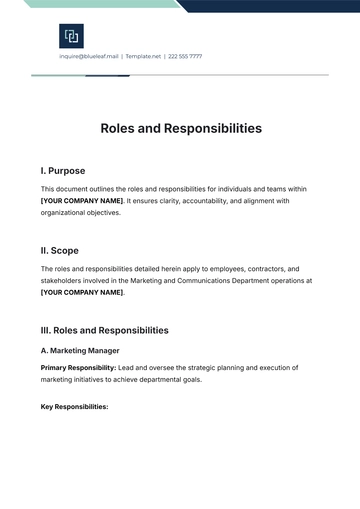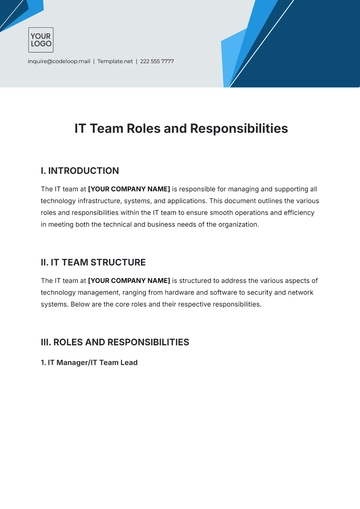Free Education Roles and Responsibilities

I. INTRODUCTION
This document outlines the key roles and responsibilities within the education system at [YOUR COMPANY NAME]. It is intended to provide clarity on the functions and expectations of each position to ensure effective collaboration, clear communication, and the successful implementation of educational initiatives.
II. ADMINISTRATIVE TEAM
Superintendent/Principal
Overall leadership of the educational institution.
Ensure that educational policies are aligned with state and federal regulations.
Provide support to staff, students, and parents.
Oversee the implementation of academic programs and initiatives.
Monitor the performance of students and staff.
Serve as the primary contact for educational stakeholders.
Assistant Principal
Assist the Principal in the management of daily operations.
Supervise students and staff.
Address disciplinary matters and support students in their academic and personal growth.
Organize and implement school events and extracurricular activities.
School Secretary/Administrative Assistant
Provide administrative support to the principal and staff.
Maintain school records, including attendance and student information.
Manage correspondence and communications with parents, students, and staff.
Organize meetings, appointments, and events for the school community.
III. TEACHING STAFF
Classroom Teachers
Develop and implement lesson plans according to curriculum guidelines.
Assess student progress and provide feedback.
Foster an inclusive, respectful, and engaging classroom environment.
Communicate regularly with parents about student performance.
Collaborate with colleagues to improve teaching strategies and student outcomes.
Special Education Teachers
Support students with disabilities, providing individualized instructional plans.
Work closely with parents, administrators, and other professionals to ensure appropriate accommodations.
Monitor and assess students' progress on specific educational goals.
Create a supportive learning environment that fosters independence and self-advocacy.
Subject-Specific Teachers (e.g., Math, Science, History)
Specialize in teaching a particular subject area to students.
Design and deliver curriculum that meets state standards.
Assess students' understanding and provide appropriate interventions.
Maintain up-to-date knowledge of developments in the subject area.
IV. SUPPORT STAFF
School Counselors
Provide guidance to students on academic, personal, and career matters.
Support students in developing social and emotional skills.
Address student concerns regarding mental health, relationships, and well-being.
Collaborate with teachers and parents to develop student support plans.
Teaching Assistants
Assist classroom teachers in delivering instruction and managing classroom activities.
Provide one-on-one or small group support to students.
Help maintain a positive and productive learning environment.
Support teachers with grading, administrative tasks, and classroom preparation.
V. PARENTS AND GUARDIANS
Collaborate with teachers and administrators to support student success.
Ensure that students attend school regularly and are prepared for learning.
Provide a supportive home environment for academic growth.
Communicate with teachers and school staff about any concerns related to the student’s well-being or education.
VI. COMMUNITY PARTNERS
Contribute resources and support for educational programs.
Engage in partnership opportunities that enhance the educational experience.
Offer expertise and mentorship to students and staff.
Support school events and initiatives that promote community involvement.
VII. CONCLUSION
The roles and responsibilities outlined above are designed to create a cohesive and effective educational environment at [YOUR COMPANY NAME]. It is the collective responsibility of all stakeholders—administrators, teachers, support staff, parents, and community partners—to ensure the success of each student and foster a positive, inclusive school culture.
- 100% Customizable, free editor
- Access 1 Million+ Templates, photo’s & graphics
- Download or share as a template
- Click and replace photos, graphics, text, backgrounds
- Resize, crop, AI write & more
- Access advanced editor
Streamline educational operations with Template.net’s Education Roles and Responsibilities Template. This customizable template, editable in our AI Editor Tool, allows educational institutions to clearly define roles for faculty, staff, and administration. Perfect for creating transparent job descriptions, it ensures that all responsibilities are clearly communicated for a productive and well-organized educational environment.





























